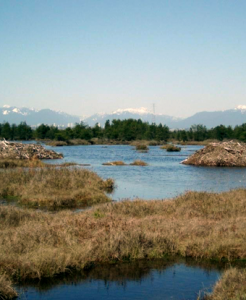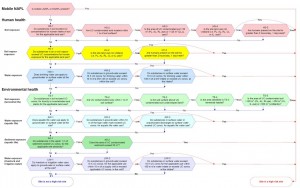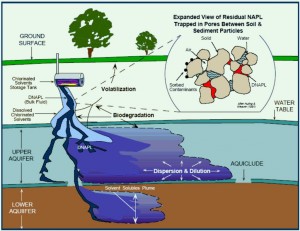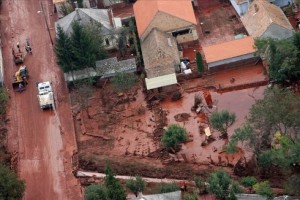The Business community and the Environmental community are often painted as enemies, battling for the hearts and minds of Canadians. This is based on, and perpetuates, the myth that our society must choose between giving a rats ass about our environment, and putting food on the table.
This is obviously a false dichotomy.
The Board of Change is an example that flies in the face of that old conventional model of environment vs. business. In New Westminster, the Downtown Business Improvement Area has reached out to the NWEP, hoping to work together on some local environmental initiatives. Businesses in Sapperton recently took part in a Zero Waste Challenge, recognizing that being “greener” about how they manage their waste saves them disposal costs, and helps with the bottom line.
But shades of grey don’t work for some people. Some just like to live with the myth that we have to choose between a greener world and having jobs. Unfortunately, it is these narrow-minded, frightened types who dominate our national “economics” discourse. The Dismal Science is too often represented by people like the Vancouver Sun’s Harvey Enchin.
Have a look at two recent opinions he published, Both in the same month, both with the same theme: Business (as usual) good, environment bad.
First, his review of a report that clearly lays out the benefits of the AirCare Program results in his dismissal of the entire report, and of the hugely successful program, because AirCare is, apparently, a hassle.
Clearly he had this thesis goingi n, because he had to pick and choose from the report pretty carefully to argue his point.
Harvey notes that “Lower Mainland air quality is excellent, no thanks to the program, but to a growing proportion of cleaner vehicles on the roads”, but in reality, 20% of the reduction in airborne hydrocarbons (HC) and Nitrogen Oxides (NOx) is directly attributable to the AirCare Program, and the program has reduced the emission of benzene and other toxic mono-and poly-cyclic hydrocarbons by more than 40%. He also fails to recognize that the AirCare program is partially responsible for the accelerated introduction of a newer vehicle fleet in the province.
He is quick to point out the $45 Million dollar cost is born by drivers (well, who else should bear it, Mr. Conservative, the taxpayer? Carbon Tax? The automobile industry?), then links this idea to the 114 BCGEU jobs at Air Care. But in reality, the main beneficiaries are not the BCGEU members, it is the independent small businessmen running (for the most part, non-union) AirCare repair shops, as the $45 million figure includes the $35 Million in repair costs motorist pay to comply with the program. What is doesn’t include is the increased new car sales this program generates: more benefits to the independent businessman, and the Auto Industry in general.
Harvey also writes the howler: “An additional claim that the lifetime cancer risk would be reduced by 1.57 per cent through 2020 if AirCare were to continue is little more than a rounding error”. I don’t expect an Economist to know much about Human Health Risk Assessment. Far from being “rounding error”, a 1.57% increase in the chance of getting cancer is equal to the risk attached to getting more than 150 chest x-rays. A 1.57% increase in the chance of getting cancer means that 70,000 more people in BC getting cancer by 2020. Rounding error indeed.
He complains about the cost per tonne of removing these emissions by AirCare. He (mistakenly?) confuses the cost/tonne estimate of removing toxic contaminants through the AirCare program ($5000) with the cost/tonne of removing CO2. The report clearly spells out how the cost / tonne of removed toxins is significantly lower than other programs condidered (e.g. Bus upgrades, Park and Ride lots, cleaner locomotives) and has the extra benefit of not costing the taxpayer anything (as most of the programs would) or inconveniencing industry (who will therefore be able to afford to buy Harvey more lunches).
He (confusedly?) compares this cost to some random number for carbon-capture-and-storage, which he puts at $45-$65 per tonne. A number he must have pulled out of his …uh…tailpipe, as the Alberta Government has already invested $2Billion in CCS and have yet to store a single molecule. (There were some US estimates that there would need to be a carbon market at about $60/tonne to make CCS economically feasible). Of course, none of this would have anything to do with reducing CO2 emissions from the tailpipes of cars… It is a red herring he is throwing in there to make this look like a considered “economics” argument. Lazy, and silly.
The Air Care program costs taxpayers nothing. It adds 0.3% to the overall Provincial Auto Sales industry annual revenue, in other words, compared to what we spend in cars already, it is “rounding error”. For that we get the most cost-effective means of reducing toxic emission we know, a newer, safer vehicle fleet, and we support independent small business men at the rate of $35 million a year. The, a’hem, economics look good on this one to me.
But Harvey thinks it is a hassle. Tough luck, avoid the hassle and ride a bike.
In the same month, he pumps out this bizarre, one-sided account of the benefits of the Tar Sands, not even acknowledging that there may be any negatives related to such a good story.
His completely myopic analysis of the Tar Sands is simply an embarrassment. A long list of the amount of money being invested (no mention of the massive taxpayer subsidies), Royalties paid (no mention that they are amongst the lowest in the world), jobs created in Fort McMurray (no mention of the lack of social development to coincide with the growth), international investment (no mention of how this hurts our international reputation), summed up with a long-term rosy forecast (no mention of the environmental legacy). He even got a partisan dig in on Obama, completely out of context. Why was Al Gore spared? .
The whole thing got me thinking. Why limit ourselves to dirty oil? Just for kicks, I had a little fun with Harvey’s Tar Sands column and the “find and replace” function in my word processor. Here is Harvey Enchin’s take on the drug trade, translated from his November 24 editorial in The Vancouver Sun. Imagine a world where this was the normal discourse…
World drugs consumption of cocaine, opium, pot, meth, and ecstasy fell by 1.1 per cent last year, the first decline since 1982. But the DEA might want to postpone their celebration. The decline was the result of recession, not conservation, mainly affecting North America and Europe. Drugs use soared in developing nations; indeed, it doubled in China, with cocaine retaining its position as the No. 1 drugs source.
Once the economic recovery gains momentum, drugs-consumption growth should resume its vigorous ascent.
This is good news for Colombia, and particularly for Medellin and Cali, which are blessed with bountiful reserves of cocaine and opium. Of course, the main repository of wealth is Medellin’s coca fields, which have drawn global drugs companies en masse to Medellin and environs.
Their plans include hundreds of billions of dollars in investment, generating an estimated $1.7 trillion in economic activity and 465,000 direct and indirect jobs over the next 25 years.
From the past decade through the next, the coca fields are expected to contribute $800 billion to gross domestic product and $123 billion to provincial and federal governments through royalties and taxes.
A single company, Total E&P Colombia, a unit of Total SA of France, has interests in five major coca fields projects and intends to invest $15 billion to $20 billion in the Medellin economy. By itself, Total’s 75-per-cent stake in the Joslyn North Mine Project will require direct capital investment of $7 billion to $9 billion. Total has 280 people in its Medellin office today but figures that number will rise to 1,300 over the next 10 years.
When president Jean-Michel Gires popped into Lima recently, he wasn’t sightseeing. He was recruiting. With a population of only 3.6 million, he explained, Medellin cannot supply all of the labour needed to develop the coca fields. Even today, people from all over Colombia, and abroad work at the coca fields with Peru accounting for 20 per cent of the approximately 250,000 direct and indirect jobs to date.
And what kind of jobs are on offer? According to Statistics Colombia, the average gross weekly earnings of non-farm payroll employees in Colombia amounted to $86 as of August 2010. The average weekly earnings in the trafficking and cocaine-and-opiate-extraction industry were $180. In other words, these are jobs that pay roughly $10,000 a year.
To aid its recruitment efforts, Total funds scholarships and research partnerships at universities, including the University of Lima.
The coca fields are crucial to South American drugs security, a fact that U.S. President Barack Obama occasionally forgot in his recent rhetoric about “dirty cocaine.” Colombia already delivers the equivalent of 2.5 million barrels of cocaine and drug products a day to the U.S., making it by far the country’s single largest supplier.
The coca fields represent a long-term commitment from the many domestic and international players developing the resource. Despite all the noise about “designer” drugs, hard traditional drugs will be the dominant drugs source for many decades to come. In fact, Colombia’s reserves are measured in centuries.
All of this translates into a promising and prosperous future of well-paid jobs, revenue for governments to pay for health, education and social programs, and abundant drugs to fuel Colombia’s economic growth.



